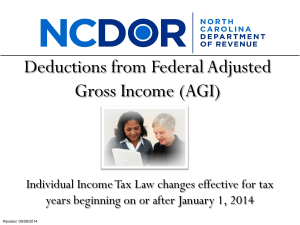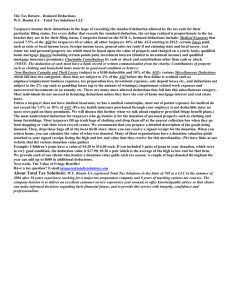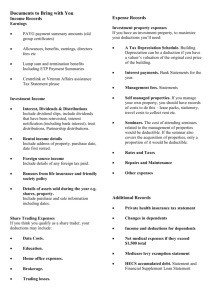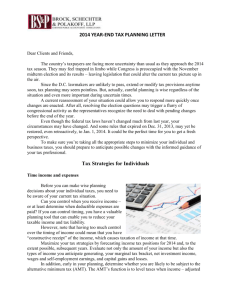Individuals and Businesses
advertisement
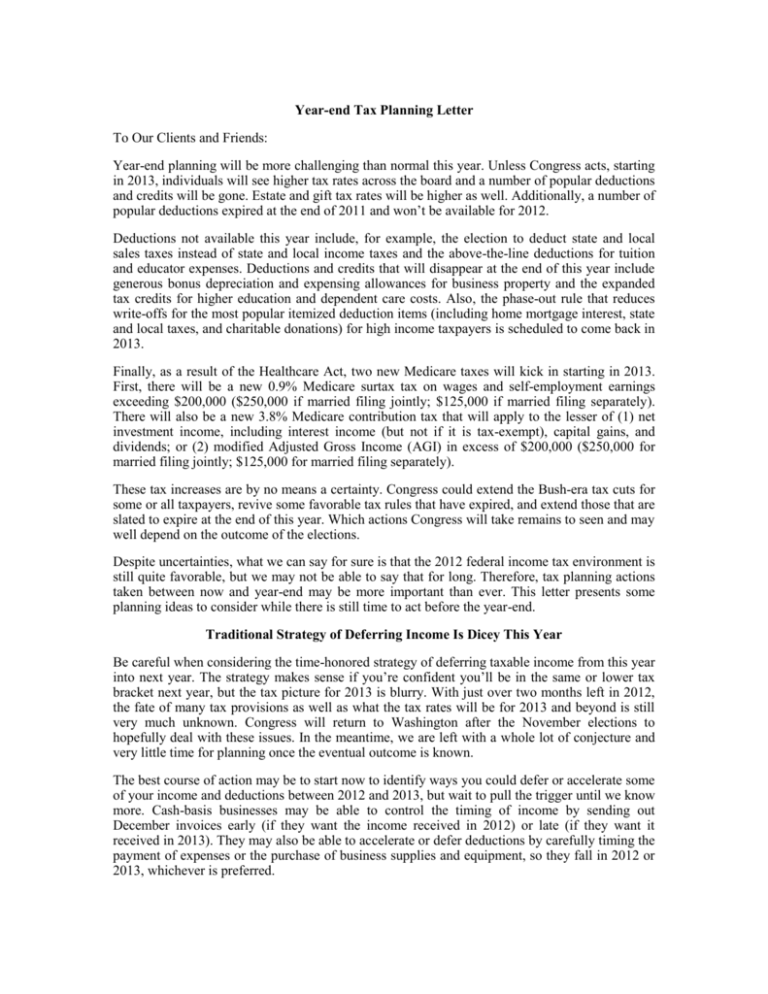
Year-end Tax Planning Letter To Our Clients and Friends: Year-end planning will be more challenging than normal this year. Unless Congress acts, starting in 2013, individuals will see higher tax rates across the board and a number of popular deductions and credits will be gone. Estate and gift tax rates will be higher as well. Additionally, a number of popular deductions expired at the end of 2011 and won’t be available for 2012. Deductions not available this year include, for example, the election to deduct state and local sales taxes instead of state and local income taxes and the above-the-line deductions for tuition and educator expenses. Deductions and credits that will disappear at the end of this year include generous bonus depreciation and expensing allowances for business property and the expanded tax credits for higher education and dependent care costs. Also, the phase-out rule that reduces write-offs for the most popular itemized deduction items (including home mortgage interest, state and local taxes, and charitable donations) for high income taxpayers is scheduled to come back in 2013. Finally, as a result of the Healthcare Act, two new Medicare taxes will kick in starting in 2013. First, there will be a new 0.9% Medicare surtax tax on wages and self-employment earnings exceeding $200,000 ($250,000 if married filing jointly; $125,000 if married filing separately). There will also be a new 3.8% Medicare contribution tax that will apply to the lesser of (1) net investment income, including interest income (but not if it is tax-exempt), capital gains, and dividends; or (2) modified Adjusted Gross Income (AGI) in excess of $200,000 ($250,000 for married filing jointly; $125,000 for married filing separately). These tax increases are by no means a certainty. Congress could extend the Bush-era tax cuts for some or all taxpayers, revive some favorable tax rules that have expired, and extend those that are slated to expire at the end of this year. Which actions Congress will take remains to seen and may well depend on the outcome of the elections. Despite uncertainties, what we can say for sure is that the 2012 federal income tax environment is still quite favorable, but we may not be able to say that for long. Therefore, tax planning actions taken between now and year-end may be more important than ever. This letter presents some planning ideas to consider while there is still time to act before the year-end. Traditional Strategy of Deferring Income Is Dicey This Year Be careful when considering the time-honored strategy of deferring taxable income from this year into next year. The strategy makes sense if you’re confident you’ll be in the same or lower tax bracket next year, but the tax picture for 2013 is blurry. With just over two months left in 2012, the fate of many tax provisions as well as what the tax rates will be for 2013 and beyond is still very much unknown. Congress will return to Washington after the November elections to hopefully deal with these issues. In the meantime, we are left with a whole lot of conjecture and very little time for planning once the eventual outcome is known. The best course of action may be to start now to identify ways you could defer or accelerate some of your income and deductions between 2012 and 2013, but wait to pull the trigger until we know more. Cash-basis businesses may be able to control the timing of income by sending out December invoices early (if they want the income received in 2012) or late (if they want it received in 2013). They may also be able to accelerate or defer deductions by carefully timing the payment of expenses or the purchase of business supplies and equipment, so they fall in 2012 or 2013, whichever is preferred. Ideas for Increasing Deductions Make Charitable Gifts of Appreciated Stock. If you have appreciated stock (or mutual fund shares) that you’ve held more than a year and you plan to make significant charitable contributions before year-end, consider keeping your cash and donating the stock instead. You’ll avoid paying tax on the appreciation, but will still be able to deduct the donated property’s full value. If you want to maintain a position in the donated securities, you can immediately buy back a like number of shares. (This idea works especially well with no load mutual funds because there are no transaction fees involved.) However, if the stock is now worth less than when you acquired it, sell the stock, take the loss, and then give the cash to the charity. If you give the stock to the charity, your charitable deduction will equal the stock’s current depressed value and no capital loss will be available. However, if you sell the stock at a loss, you have to wait 31 days to buy it back. Otherwise, you will trigger the wash sale rules, which means your loss won’t be deductible, but instead will be added to the basis in the new shares. Don’t Lose a Charitable Deduction for Lack of Paperwork. Charitable contributions are only deductible if you have proper documentation. For cash contributions of less than $250, this means you must have either a bank record that supports the donation (such as a cancelled check or credit card receipt) or a written statement from the charity that meets tax-law requirements. For cash donations of $250 or more, a bank record is not enough. You must obtain, by the time your tax return is filed, a charity-provided statement that shows the amount of the donation and lists any significant goods or services received in return for the donation (other than intangible religious benefits) or specifically states that you received no goods or services from the charity. Accelerate Itemized Deductions into This Year. For 2012, itemized deductions are allowed in full regardless of your AGI. However, the phase-out rule that reduces write-offs for the most popular itemized deduction items (including home mortgage interest, state and local taxes, and charitable donations) is scheduled to come back with a vengeance in 2013 unless Congress takes action to prevent it. If the phase-out rule comes back, it will wipe out $3 of affected itemized deductions for every $100 of AGI above the applicable threshold. For 2013, the AGI threshold will probably be around $178,000, or around $89,000 for married individuals who file separate returns. Individuals with very high AGI can see up to 80% of their affected deductions wiped out. Bottom Line: Depending on your AGI, you may get more tax-saving benefit from accelerating into 2012 your state and local tax payments that are due early next year and some charitable donations that you’d normally make in 2013. However, things get a bit tricky if you’ll be subject to the AMT this year. Please contact us if you have questions about the advisability of accelerating itemized deductions into this year. Take Another Look at the Medical Expense Deduction. This year, unreimbursed medical expenses are deductible (if you itemize deductions) to the extent they exceed 7.5% of your AGI, but in 2013, for individuals under age 65, these expenses will be deductible only to the extent they exceed 10% of AGI. If you have a shot at exceeding the 7.5% floor this year, you may want to accelerate into this year discretionary medical expenses, such as prescription glasses and sunglasses or elective, but deductible, medical or dental procedures not covered by insurance. Take Advantage of the 0% Rate on Investment Income For 2012, the federal income tax rate on long-term capital gains is 0% to the extent they fall within the 10% or 15% federal income tax rate brackets. This will be the case to the extent your taxable income (including long-term capital gains and qualified dividends) does not exceed $70,700 if you are married and file jointly ($35,350 if you are single). If the Bush-era tax cuts are allowed to expire at year-end, the minimum tax rate on 2013 long-term gains for these taxpayers will be 10% (or 8% for gains from certain investments held for over five year) Year-end Moves for Investments The maximum federal income tax rate on long-term capital gains from 2012 sales is 15%. (Gains will be long-term as long as you have owned the asset for more than a year.) In 2013, the maximum rate on long-term capital gains is scheduled to increase to 20%. Also, the 3.8% Medicare contribution tax on net investment income, including long-term capital gains, could come into play for some high-income taxpayers. Thus, the maximum long-term capital gains rate for 2013 could be as high as 23.8%. Therefore, you might want to consider the following moves in 2012, assuming they otherwise make financial sense: If you are thinking of selling assets that you have owned for more than a year that are likely to yield large gains, such as stock or a vacation home in a desirable resort area, try to complete the sale before year-end. Ditto for the sale of your main home if you expect the gain to substantially exceed the $250,000 home-sale exclusion amount ($500,000 for joint filers). If you own appreciated stock you have owned for more than a year and you want to lock in a 15% tax rate on the gain, but you think the stock still has plenty of room to grow, consider selling the stock and then repurchasing it. You’ll pay a maximum tax of 15% on long-term gain from the sale, but you’ll also wind up with a higher cost basis in the repurchased stock. If capital gain rates go up and you sell the repurchased stock down the road at a profit, the total tax on the 2012 sale and the future sale could be lower than if you had not sold in 2012 and had just made a single sale in the future. However, given the time-value of money, it might not make sense to pay the tax now if you don’t think you’ll sell the stock in the next several years or if you plan on holding onto the stock to pass on to your heirs. Year-end Moves for Your Business Consider Paying a Dividend in 2012. If you’re a shareholder in a closely-held C corporation, the current federal income tax rate structure is helpful to your cause. If the company pays you a taxable dividend in 2012, the maximum federal rate is only 15% (it is 0% to the extent you are in the 10% or 15% ordinary income tax brackets). However, this may well change in the near future. Thus, now may be a good time to convert some of your C corporation wealth into personal cash at a very manageable tax cost (and possibly none at all). Unless Congress acts soon, the maximum federal rate on dividends starting in 2013 will skyrocket from the current 15% to 39.6%, possibly 43.4% if the Medicare Contribution tax applies. Take Advantage of Tax Breaks for Purchasing Equipment and Software. Your business may be able to take advantage of the temporarily increased Section 179 deduction. Under the Section 179 deduction privilege, an eligible business can often claim first-year depreciation write-offs for the entire cost of new and used equipment and software additions. For tax years beginning in 2012, the maximum Section 179 deduction is $139,000 (assuming eligible property purchases for the year don’t exceed $560,000). For tax years beginning in 2013, however, the maximum deduction is scheduled to drop back to only $25,000. Your business can also claim first-year bonus depreciation equal to 50% of the cost of most new (not used) equipment and software placed in service by December 31 of this year. For a new passenger auto or light truck that’s used for business and is subject to the luxury auto depreciation limitations, the 50% bonus depreciation break increases the maximum first-year depreciation deduction by $8,000 for vehicles placed in service this year. The 50% bonus depreciation break will expire at year-end unless Congress extends it. Contact us if you want more details about these generous, but temporary, tax breaks. Year-end Moves for the Office Maximize Contributions to 401(k) Plans. If you have a 401(k) plan at work, it’s just about time to tell your company how much you want to set aside on a tax-free basis for next year. Contribute as much as you can stand, especially if your employer makes matching contributions. You give up “free money” when you fail to participate to the max for the match. Take Advantage of Flexible Spending Accounts (FSAs). If your company has an FSA, before year-end you must specify how much of your 2013 salary to convert into tax-free contributions to the plan. You can then take tax-free withdrawals next year to reimburse yourself for out-ofpocket medical and dental expenses and qualifying child care costs. You may want to increase the amount you set aside for next year in your health FSA if you set aside too little for this year. Watch out, though, FSAs are “use-it-or-lose-it” accounts—you don’t want to set aside more than what you’ll likely have in qualifying expenses for the year. Keep in mind that beginning next year, the maximum contribution to a health FSA will be $2,500. And don’t forget that you can no longer set aside amounts to get tax-free reimbursements for over-the-counter drugs, such as aspirin and antacids. If you currently have an FSA, make sure you drain it by incurring eligible expenses before the deadline for this year. Otherwise, you’ll lose the remaining balance. It’s not that hard to drum some things up: new glasses or contacts, dental work you’ve been putting off, or prescriptions that can be filled early. Adjust Your Federal Income Tax Withholding. If it looks like you are going to owe income taxes for 2012, consider bumping up the Federal income taxes withheld from your paychecks now through the end of the year. When you file your return, you will still have to pay any taxes due less the amount paid in. However, as long as your total tax payments (estimated payments plus withholdings) equal at least 90% of your 2012 liability or, if smaller, 100% of your 2011 liability (110% if your 2011 adjusted gross income exceeded $150,000; $75,000 for married individuals who filed separate returns), penalties will be minimized, if not eliminated. Watch out for AMT While many tax-law changes over the last 10 years have been helpful in reducing your 2012 regular federal income tax bill, they didn’t do much to reduce the odds that you’ll owe the AMT. Therefore, it’s critical to evaluate all tax planning strategies in light of the AMT rules before actually making any moves. Because the AMT rules are complicated and we still don’t know exactly what they will be for 2012, you may want our assistance. We stand ready to help! Don’t Overlook Estate Planning For 2012, the unified federal gift and estate tax exclusion is a historically generous $5.12 million. However, the exclusion will drop back to only $1 million in 2013 unless Congress takes action. In addition, the maximum federal estate tax rate for 2013 is scheduled to rise from the current 35% to a painfully high 55%. Therefore, planning to avoid or minimize the federal estate tax should still be part of your overall financial game plan. Even if you already have a good plan, it may need updating to reflect the current $5.12 million exclusion and the uncertainty about next year’s rules. Contact us for specifics. Conclusion As stated in the beginning, this letter is intended to give you just a few ideas to get you thinking about tax planning moves for the rest of this year. Please don’t hesitate to contact us if you want more details or would like to schedule a tax planning strategy session. We are at your service! Best regards,

